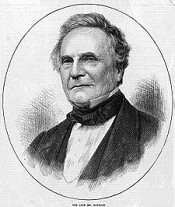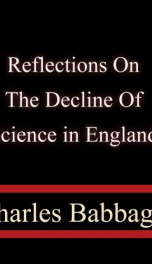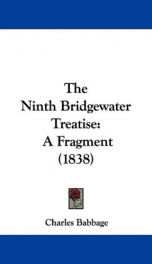Babbage Charles

Charles Babbage, FRS (26 December 1791 – 18 October 1871)[2] was an English mathematician, philosopher, inventor and mechanical engineer who originated the concept of a programmable computer . Parts of his uncompleted mechanisms are on display in the London Science Museum. In 1991, a perfectly functioning difference engine was constructed from Babbage's original plans. Built to tolerances achievable in the 19th century, the success of the finished engine indicated that Babbage's machine would have worked. Nine years later, the Science Museum completed the printer Babbage had designed for the difference engine, an astonishingly complex device for the 19th century. Considered a "father of the computer"[3] Babbage is credited with inventing the first mechanical computer that eventually led to more complex designs. The birthplace of Charles Babbage is still disputed, but he was most likely born in 44 Crosby Row, Walworth Road, London, England. A blue plaque on the junction of Larcom Street and Walworth Road commemorates the event. Babbage's date of birth was given in his obituary in The Times as 25 December 1792. However after the obituary appeared, a nephew wrote to say that Charles Babbage actually was born one year earlier, in 1791. The parish register of St. Mary's Newington, London, shows that Babbage was baptized on 6 January 1792, supporting a birth year of 1791.[4][5][6] Charles' father, Benjamin Babbage, was a banking partner of the Praeds who owned the Bitton Estate in Teignmouth. His mother was Betsy Plumleigh Teape. In 1808, the Babbage family moved into the old Rowdens house in East Teignmouth, and Benjamin Babbage became a warden of the nearby St. Michael’s Church. His father's money allowed Charles to receive instruction from several schools and tutors during the course of his elementary education. Around the age of eight he was sent to a country school in Alphington near Exeter to recover from a life-threatening fever. His parents ordered that his "brain was not to be taxed too much" and Babbage felt that "this great idleness may have led to some of my childish reasonings." For a short time he attended King Edward VI Grammar School in Totnes, South Devon, but his health forced him back to private tutors for a time.[7] He then joined a 30-student Holmwood academy, in Baker Street, Enfield, Middlesex under Reverend Stephen Freeman. The academy had a well-stocked library that prompted Babbage's love of mathematics. He studied with two more private tutors after leaving the academy. Of the first, a clergyman near Cambridge, Babbage said, "I fear I did not derive from it all the advantages that I might have done." The second was an Oxford tutor from whom Babbage learned enough of the Classics to be accepted to Cambridge. Babbage arrived at Trinity College, Cambridge in October 1810.[8] He had read extensively in Leibniz, Joseph Louis Lagrange, Thomas Simpson, and Lacroix and was seriously disappointed in the mathematical instruction available at Cambridge. In response, he, John Herschel, George Peacock, and several other friends formed the Analytical Society in 1812. Babbage, Herschel and Peacock were also close friends with future judge and patron of science Edward Ryan. Babbage and Ryan married two sisters.[9] In 1812 Babbage transferred to Peterhouse, Cambridge.[8] He was the top mathematician at Peterhouse, but did not graduate with honours. He instead received an honorary degree without examination in 1814. On 25 July 1814, Babbage married Georgiana Whitmore at St. Michael's Church in Teignmouth, Devon. The couple lived at Dudmaston Hall,[10] Shropshire (where Babbage engineered the central heating system), before moving to 5 Devonshire Street, Portland Place, London. Charles and Georgiana had eight children,[11] but only three — Benjamin Herschel, Georgiana Whitmore, and Henry Prevost — survived to adulthood. Georgiana died in Worcester on 1 September 1827. Charles' father, wife, and at least one son all died in 1827. These deaths caused Babbage to go into a mental breakdown which delayed the construction of his machines. His youngest son, Henry Prevost Babbage (1824-1918), went on to create six working difference engines based on his father's designs,[12] one of which was sent to Harvard University where it was later discovered by Howard H. Aiken, pioneer of the Harvard Mark I. Henry Prevost's 1910 Analytical Engine Mill, previously on display at Dudmaston Hall, is now on display at the Science Museum.[13] Charles Babbage died at age 79 on 18 October 1871, and was buried in London's Kensal Green Cemetery. According to Horsley, Babbage died "of renal inadequacy, secondary to cystitis."[14] In 1983 the autopsy report for Charles Babbage was discovered and later published by one of his descendants.[15][16] A copy of the original is also available.[17] Half of Babbage's brain is preserved at the Hunterian Museum in the Royal College of Surgeons in London.[18][19] Babbage sought a method by which mathematical tables could be calculated mechanically, removing the high rate of human error. Three different factors seem to have influenced him: a dislike of untidiness; his experience working on logarithmic tables; and existing work on calculating machines carried out by Wilhelm Schickard, Blaise Pascal, and Gottfried Leibniz. He first discussed the principles of a calculating engine in a letter to Sir Humphry Davy in 1822. Babbage's machines were among the first mechanical computers, although they were not actually completed, largely because of funding problems and personality issues. He directed the building of some steam-powered machines that achieved some success, suggesting that calculations could be mechanized. Although Babbage's machines were mechanical and unwieldy, their basic architecture was very similar to a modern computer. The data and program memory were separated, operation was instruction based, the control unit could make conditional jumps and the machine had a separate I/O unit. In Babbage’s time, numerical tables were calculated by humans who were called ‘computers’, meaning "one who computes", much as a conductor is "one who conducts". At Cambridge, he saw the high error-rate of this human-driven process and started his life’s work of trying to calculate the tables mechanically. He began in 1822 with what he called the difference engine, made to compute values of polynomial functions. Unlike similar efforts of the time, Babbage's difference engine was created to calculate a series of values automatically. By using the method of finite differences, it was possible to avoid the need for multiplication and division. The first difference engine was composed of around 25,000 parts, weighed fifteen tons (13,600 kg), and stood 8 ft (2.4 m) high. Although he received ample funding for the project, it was never completed. He later designed an improved version, "Difference Engine No. 2", which was not constructed until 1989-1991, using Babbage's plans and 19th century manufacturing tolerances. It performed its first calculation at the London Science Museum returning results to 31 digits, far more than the average modern pocket calculator. The London Science Museum has constructed two Difference Engines, according to Babbage's plans for the Difference Engine No 2. One is owned by the museum; the other, owned by technology millionaire Nathan Myhrvold, went on exhibit at the Computer History Museum[20] in Mountain View, California on 10 May 2008.[21] The two models that have been constructed are not replicas; until the assembly of the first Difference Engine No 2 by the London Science Museum, no model of the Difference Engine No 2 existed. Soon after the attempt at making the difference engine crumbled, Babbage started designing a different, more complex machine called the Analytical Engine. The engine is not a single physical machine but a succession of designs that he tinkered with until his death in 1871. The main difference between the two engines is that the Analytical Engine could be programmed using punch cards. He realized that programs could be put on these cards so the person had only to create the program initially, and then put the cards in the machine and let it run. The analytical engine would have used loops of Jacquard's punched cards to control a mechanical calculator, which could formulate results based on the results of preceding computations. This machine was also intended to employ several features subsequently used in modern computers, including sequential control, branching, and looping, and would have been the first mechanical device to be Turing-complete. Ada Lovelace, an impressive mathematician, and one of the few people who fully understood Babbage's ideas, created a program for the Analytical Engine. Had the Analytical Engine ever actually been built, her program would have been able to calculate a sequence of Bernoulli numbers. Based on this work, Lovelace is now widely credited with being the first computer programmer.[22] In 1979, a contemporary programming language was named Ada in her honour. Shortly afterward, in 1981, a satirical article by Tony Karp in the magazine Datamation described the Babbage programming language as the "language of the future".[23] While the abacus and mechanical calculator have been replaced by electronic calculators using microchips, the recent advances in MEMS and nanotechnology have led to recent high-tech experiments in mechanical computation. The benefits suggested include operation in high radiation or high temperature environments.[24] These modern versions of mechanical computation were highlighted in the magazine The Economist in its special "end of the millennium" black cover issue in an article entitled "Babbage's Last Laugh".[25] The article highlighted work done at University of California Berkeley by Ezekiel Kruglick. In this Doctoral Dissertation[26] the researcher reports mechanical logic cells and architectures sufficient to implement the Babbage Analytical engine (see above) or any general logic circuit. Carry-shift digital adders and various logic elements are detailed as well as modern analysis on required performance for microscopic mechanical logic.
do you like this author?
What readers are saying
What do you think? Write your own comment on this book!
write a commentWhat readers are saying
What do you think? Write your own comment on this author!
write a commentBook list

thoughts on the principles of taxation with reference to a property tax and it
Series:
Unknown
Year:
Unknown
Raiting:
5/5
Show more
add to favoritesadd In favorites
Book list

thoughts on the principles of taxation with reference to a property tax and it
Series:
Unknown
Year:
Unknown
Raiting:
5/5
Show more
add to favoritesadd In favorites

observations on the temple of serapis at pozzuoli near naples with an attempt t
Series:
Unknown
Year:
Unknown
Raiting:
3.5/5
Show more
add to favoritesadd In favorites

examples of the solutions of functional equations
Series:
Unknown
Year:
Unknown
Raiting:
3.5/5
Show more
add to favoritesadd In favorites

Reflections on the Decline of Science in England
Series:
Unknown
Year:
Unknown
Raiting:
4/5
This book was converted from its physical edition to the digital format by a community of volunteers. You may find it for free on the web. Purchase of the Kindle edition includes wireless delivery.
Show more
add to favoritesadd In favorites

On the Economy of Machinery and Manufactures
Series:
Unknown
Year:
Unknown
Raiting:
1.5/5
Purchase of this book includes free trial access to www.million-books.com where you can read more than a million books for free. This is an OCR edition with typos. Excerpt from book: great difficulties, and I have been unwilling to write upon it, because I do not see my way. I will only here advert to one difficulty. What constitutes an invention?Few simple mechanical contrivances are new; and most combinations may be viewed as species, and classed under genera of more or less generality; and may, in consequence, be pronounced old or new, according to the mechanical knowledge of the person who gives his opinion. Some of my critics have amused their readers with the wildness of the schemes I have occasionally thrown out; and I myself have sometimes smiled along with them. Perhaps it were wiser for present reputation to offer nothing but profoundly meditated plans, but I do not think knowledge will be most advanced by that course; such sparks may kindle the energies of other minds more favourably circumstanced for pursuing the inquiries. Thus I have now ventured to give some speculations on the mode of blowing furnaces for smelting iron; and even supposing them to be visionary, it is of some importance thus to call the attention of a large population, engaged in one of our most extensive manufactures, to the singular fact, that four-fifths of the steam power used to blow their furnaces actually cools them. I have collected, with some pains, the criticisms on the first edition of this work, and have availed myself of much information which has been communicated to me by my friends, for the improvement of the present volume. If I have succeeded in expressing what I had to explain with perspicuity, I am aware that much of this clearness is due to my friend, Dr. Fitton, to whom both the present and the former edition are indebted for such an examination and correction, as an author himself has very rarely the power to bestow. Several of these have probabl...
Show more
add to favoritesadd In favorites
What readers are saying
What do you think? Write your own comment on this author!
write a commentif you like Babbage Charles try:
readers also enjoyed
What readers are saying
What do you think? Write your own comment on this author!
write a commentGenre
if you like Babbage Charles try:
readers also enjoyed
Do you want to exchange books? It’s EASY!
Get registered and find other users who want to give their favourite books to good hands!


